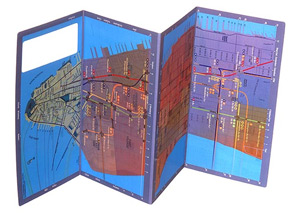 |


![]()
> archived articles
> write for core! be famous!
|
Letter from the Front Lines A battle-weary inventor meets his map by Ian White |
Starting a business isn't something you want to do. It's hard. It's lonely. It's tremendously debt-enhancing. But I wouldn't change it for the world. The ability to shape my destiny on daily basis is a unique opportunity. Each day brings uncertainty. It's the only reason I get up each morning. In February 2001 I was laid off from my job as a brand strategist and all-around business mind for a small design firm. By august 2001 my unemployment had expired. Times were tough and they were about to get much tougher. Classmates from my MBA program were in a similar position. Over the past two-plus years, I did what the Protestant work ethic told me--be productive. Unfortunately, society said my contributions were not welcome. Real estate agent, waiter, telemarketer, pedicab driver, focus group participant, mystery shopper, failed petty drug dealer...odd jobs to keep me afloat (not really). Living in New York, the MTA subway map became a daily study. Without a newspaper or other distraction, riding the train to and from work (or unemployment office) left several choices--stare at people, stare at the subway ads, or stare at the map. The map held the greatest interest for me, despite the fact that it remains relatively static. At this time I noticed a number of new advertisements using lenticular printing, an old technology, but executed with modern precision on a scale not previously possible. This allows a printer to superimpose two or more images on a single surface. But using such a magical technology to represent Britney Spears in evening wear/bathing suit somehow seemed to fall short of its potential as a vehicle for transferring information. It was around this time that the notion of Urban Mapping first took shape.
The product I developed is a foldable city map using lenticular technology to superimpose three maps into one: Street map, subway map and neighborhood map. By tilting it back and forth, the user can see different layers of information on the same surface. It's a simple idea that results in a delightful experience. I was able to create a (seemingly) compelling product. But the road to success is long, winding, and fraught with pitfalls. Prototype One entailed two prima donna designers, a rotten manufacturer, and premature excitement. The result was something close to a proof-of-concept; interesting, but not yet compelling. Prototype Two leveraged six additional months of research and design, testing color contrast, line orientation, registration tolerances and manufacturing. I was proud of the result, and my design staff shared the excitement, helping to further my efforts. This was a true proof-of-concept, something which allowed people to see past the 'thing,' onto the 'idea.' During this incubation period, I spent a great amount of time and effort courting investors, retailers and other potential partners. I am either fool, genius or simply na´ve. It is unclear which, but any of the three seem viable labels. People drastically underestimate what it takes to get something off the ground. "Why don't you get a job and do the map thing 'on weekends'" is a common response. Getting to the correct contact at some organizations takes more than 30 phone calls, not counting the calls that weren't returned. Multiply that by 100 retailers, and there is no time remaining in the week to do anything else. Skills, while necessary, are not sufficient; tenacity and luck are significantly more important. The notion of selling maps in Big Department Store, on top of Large Tourist Attraction, getting in touch with a Well Known Restaurant Review Publisher or creating a Map of Sports Stadiums are all answered with the same question: "Do you have contacts?" This generally gives pause. So the execution is the only thing that matters, 'cause the ideas are cheap. What creates value is making the idea actionable, translating it into something meaningful that attracts resources. At first I was competing against myself--my ability to marshal scarce resources, develop a compelling and distinctive product, protect intellectual property. At an industry event, a large publisher with whom I had previously been in confidential negotiations, released a competing product--a knock-off. This was my welcome to the coming out party. More recently, I received certified mail from a large Washington, DC law firm, commanding me to abandon the use of certain intellectual property. Notwithstanding the fact that the law afforded me rights to this intellectual property, this consumes precious resources--legal fees and my time. Each day is a challenge with obstacles erected for the sole purpose of slowing me down, preventing the idea from jelling. There is a god to all non-believers, but he is one of a very different kind. He is the god of commerce, and his objectives are clear: to rein havoc. So I press on. Each day brings new challenges, set-backs become routine, but small victories are amplified and savored. No one can tell you what an entrepreneur does for a living. You need to live it. |
Ian White is a design and business strategist, the inventor of the Dyanamap, and the founder of Urbanmapping. Give him some support at www.urbanmapping.com. |
